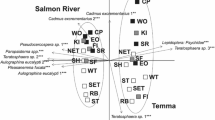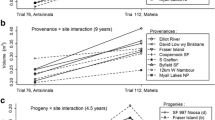Abstract
The potential effects of climate change plus the expansion of eucalypt plantations to less favorable sites, beyond those where they are currently planted, requires exploring novel eucalypt germplasm to identify taxa less vulnerable to biotic and abiotic stress. To improve plant adaptation to new environments, the first step is breeding programs and/or forming base populations of new and different species. But, to achieve this, what species should be chosen from the almost 1000 existing eucalypt species? To tackle this question, this work evaluated various eucalypt species from different provenances at two assessment in five environments to verify (1) the need for environmental stratification; (2) the best species and provenances per environment, and (3) environmental stability, adaptability, and changes between assessment. The mortality and diameter at breast height of 27 eucalypt taxa originating from wild populations and seed orchards were evaluated. To evaluate the data, we took a factor analytic mixed modelling approach to define mega-environments (groups of similar sites) and characterize the interactions of these with the selected taxa. The analyses allowed both quantitative and graphical identification of optimal combinations of species and sites. Promising taxa identified include Corymbia citriodora subsp. variegata, C. henryi, Eucalyptus longirostrata, E. major and E. urophylla. We place the results of this process in the context of ongoing domestication and breeding of new taxa for challenging sites in Brazil.





Similar content being viewed by others
References
Allen CD, Breshears DD, McDowell NG (2015) On underestimation of global vulnerability to tree mortality and forest die-off from hotter drought in the Anthropocene. Ecosphere 6:1–55. https://doi.org/10.1890/ES15-00203.1
Aparecida C, Reis F, Francisco De Assis T et al (2014) Empresa Brasileira de Pesquisa Agropecuária Embrapa Florestas Ministério da Agricultura, Pecuária e Abastecimento Corymbia torelliana: estado da arte de pesquisas no Brasil. Embrapa Florestas
Araujo MJ, Paula RC, Campoe OC, Carneiro RL (2019) Adaptability and stability of eucalypt clones at different ages across environmental gradients in Brazil. For Ecol Manag 454:117631. https://doi.org/10.1016/j.foreco.2019.117631
Assis FT (2014) Melhoramento genético de Eucalyptus: desafios e perspectivas. In: Encontro Brasileiro de Silvicultura. Malinovski, Campinas, pp 127–148
Assis TF, Abad JI, Aguiar AM (2015) Melhoramento Genético do Eucalipto. In: Mauro Valdir SchumacherMárcio Viera (ed) Silvicultura do Eucalipto no Brasil, 1st edn. UFSM, Santa Maria, RS, pp 225–247
Bernardo R (2020) Reinventing quantitative genetics for plant breeding: something old, something new, something borrowed, something BLUE. Heredity 125:375–385. https://doi.org/10.1038/s41437-020-0312-1
Brawner JT, Lee DJ, Meder R et al (2013) Classifying genotype by environment interactions for targeted germplasm deployment with a focus on Eucalyptus. Euphytica 191:403–414. https://doi.org/10.1007/s10681-013-0892-4
Brown JKM, Rant JC (2013) Fitness costs and trade-offs of disease resistance and their consequences for breeding arable crops. Plant Pathol 62:83–95. https://doi.org/10.1111/ppa.12163
Bush D, Kain D, Kanowski P, Matheson C (2015) Genetic parameter estimates informed by a marker-based pedigree: a case study with Eucalyptus cladocalyx in southern Australia. Tree Genet Genomes 11:1–16. https://doi.org/10.1007/s11295-014-0798-x
Bush D, Harwood C, Pinkard E (2018) Species for changing climates—Australian dryland forestry opportunities. Aust for 81:102–115. https://doi.org/10.1080/00049158.2017.1420288
Castro CEC, Silva PHM, Araújo MJ et al (2018) Adaptability, stability and productivity of Eucalyptus grandis progenies. Scientia Forestalis 46:157–166
Dickinson GR, Wallace HM, Lee DJ (2013) Reciprocal and advanced generation hybrids between Corymbia citriodora and C. torelliana: forestry breeding and the risk of gene flow. Ann for Sci 70:1–10. https://doi.org/10.1007/s13595-012-0231-2
Eberhart SA, Russell WA (1966) Stability parameters for comparing varieties. Crop Sci 6:36–40. https://doi.org/10.2135/cropsci1966.0011183x000600010011x
Eldridge K, Davidson J, Harwood C, van Wyk G (1994) Eucalypt domestication and breeding. Oxford University Press, Oxford
Elli EF, Sentelhas PC, Huth N et al (2020) Gauging the effects of climate variability on Eucalyptus plantations productivity across Brazil: a process-based modelling approach. Ecol Ind 114:106325. https://doi.org/10.1016/j.ecolind.2020.106325
Ferreira V, Boyero L, Calvo C et al (2019) A Global assessment of the effects of eucalyptus plantations on stream ecosystem functioning. Ecosystems 22:629–642. https://doi.org/10.1007/s10021-018-0292-7
Finlay KW, Wilkinson GN (1963) The analysis of adaptation in a plant-breeding programme. Aust J Agric Res 14:742–754. https://doi.org/10.1071/AR9630742
Fonseca SM, Resende MDV, Alfenas AC et al (2010) Recursos Genéticos no melhoramento do eucalipto. In: Fonseca SM (ed) Manual prático de melhoramento genético de eucalipto. UFV, Viçosa, pp 13–37
Gardner RAW, Little KM, Arbuthnot A (2007) Wood and fibre productivity potential of promising new eucalypt species for coastal Zululand, South Africa. Aust For 70:37–47. https://doi.org/10.1080/00049158.2007.10676261
Gilmour AR, Gogel BJ, Welham SJ (2015) ASReml user guide structural specification
Gonçalves JLDM, Alvares CA, Higa AR et al (2013) Integrating genetic and silvicultural strategies to minimize abiotic and biotic constraints in Brazilian eucalypt plantations. For Ecol Manag 301:6–27. https://doi.org/10.1016/j.foreco.2012.12.030
Harwood C (2011) Introductions: doing it right. In: Walker J (ed) Developing a eucalypt resource: learning from Australia and Elsewhere. Christchurch, New Zealand, pp 43–54
Henson M, Smith HJ (2007) Achievements in forest tree genetic improvement in Australia and New Zealand 1: Eucalyptus pilularis Smith tree improvement in Australia. Aust for 70:4–10. https://doi.org/10.1080/00049158.2007.10676255
Ibá (2020) RELATÓRIO ANUAL Annual Report
Lee DJ (2007) Achievements in forest tree genetic improvement in Australia and New Zealand 2: development of Corymbia species and hybrids for plantations in eastern Australia. Aust for 70:11–16. https://doi.org/10.1080/00049158.2007.10676256
Lee D, Nikles G, Pomroy P et al (2005) Corymbia species and hybrids: a solution to Queensland hardwood plantations? In: Underpinning development of a profitable hardwood plantation industry in northern Australia by research into Corymbia species and hybrids, pp 5–7
Lee DJ, Huth JR, Brawner JT, Dickinson GR (2009) Comparative performance of corymbia hybrids and parental species in subtropical Queensland and implications for breeding and deployment. Silvae Genetica 58:205–212. https://doi.org/10.1515/sg-2009-0026
Lee DJ, Huth JR, Osborne DO, Hogg BW (2010) Selecting hardwood taxa for wood and fibre production in Queensland’s subtropics. Aust for 73:106–114. https://doi.org/10.1080/00049158.2010.10676316
Malosetti M, Ribaut J-M, van Eeuwijk FA (2013) The statistical analysis of multi-environment data: modeling genotype-by-environment interaction and its genetic basis. Front Physiol 4:44. https://doi.org/10.3389/fphys.2013.00044
Meyer K (2009) Factor-analytic models for genotype × environment type problems and structured covariance matrices. Genet Sel Evol 41:1–11. https://doi.org/10.1186/1297-9686-41-21
Moraes CB, Brizolla TF, Teixeira LG et al (2014a) Estimativas dos parâmetros genéticos para seleção de árvores de Eucalyptus. Scientia Forestalis 42:623–629
Moraes CB, Freitas TCM, Pieroni GB et al (2014b) Estimativas de parâmetros genéticos para seleção precoce de clones de Eucalyptus para região com ocorrência de geadas. Scientia Forestalis 42:219–227
Nuvunga J, Oliveira LA, Kellen A et al (2015) Factor analysis using mixed models of multi-environment trials with different levels of unbalancing. Genet Mol Res 14:14262–14278. https://doi.org/10.4238/2015.November.13.10
Peixouto LS, Nunes JAR, Furtado DF (2016) Factor analysis applied to the G+GE matrix via REML/BLUP for multi-environment data. Crop Breed Appl Biotechnol 16:1–6. https://doi.org/10.1590/1984-70332016v16n1a1
R Core Team (2019) R: a language and environment for statistical computing
Resende MD (2007) Matemática e estatística na análise de experimentos e no melhoramento genético. Embrapa Florestas, Colombo
Rodas CA, Lombard L, Gryzenhout M et al (2005) Cylindrocladium blight of Eucalyptus grandis in Colombia. Australas Plant Pathol 34:143–149. https://doi.org/10.1071/AP05012
Shepherd M, Kasem S, Lee DJ, Henry R (2008) Mapping species differences for adventitious rooting in a Corymbia torelliana x Corymbia citriodora subspecies variegata hybrid. Tree Genet Genomes 4:715–725. https://doi.org/10.1007/s11295-008-0145-1
Silva PHM, Miranda AC, Moraes MLT et al (2013) Selecting for rust (Puccinia psidii) resistance in Eucalyptus grandis in São Paulo State, Brazil. For Ecol Manag 303:91–97. https://doi.org/10.1016/j.foreco.2013.04.002
Silva PHM, Lee DJ, Miranda AC et al (2017) Sobrevivência e crescimento inicial de espécies de eucalipto em diferentes condições climáticas. Scientia Forestalis 45:563–571. https://doi.org/10.18671/scifor.v45n115.13
Silva PHM, Paula RC, Moraes MLT (2018) Improvement of Eucalypts populations. IPEF, Piracicaba
Silva PHM, Brune A, Alvares CA et al (2019a) Selecting for stable and productive families of eucalyptus urophylla across a country-wide range of climates in Brazil. Can J for Res 49:87–95. https://doi.org/10.1139/cjfr-2018-0052
Silva PHM, Marco M, Alvares CA et al (2019b) Selection of Eucalyptus grandis families across contrasting environmental conditions. Crop Breed Appl Biotechnol 19:47–54. https://doi.org/10.1590/1984-70332019v19n1a07
Smith A, Cullis B, Thompson R (2001) Analyzing variety by environment data using multiplicative mixed models and adjustments for spatial field trend. Biometrics 57:1138–1147. https://doi.org/10.1111/j.0006-341X.2001.01138.x
Thompson R, Cullis B, Smith A, Gilmour A (2003) A sparse implementation of the average information algorithm for factor analytic and reduced rank variance models. Aust N Z J Stat 45:445–459. https://doi.org/10.1111/1467-842X.00297
van Eeuwijk FA, Bustos-Korts D, Malosetti M (2016) What should students in plant breeding know about the statistical aspects of genotype × Environment interactions? Crop Sci 56:2119–2140. https://doi.org/10.2135/cropsci2015.06.0375
Yan W, Hunt LA, Sheng Q, Szlavnics Z (2000) Cultivar evaluation and mega-environment investigation based on the GGE biplot. Crop Sci 40:597–605. https://doi.org/10.2135/cropsci2000.403597x
Acknowledgements
The authors thank University of São Paulo and the companies Amcel, ArborGen, Aperam, Bracell, CMPC, Duratex, Eldorado, International Paper, Klabin, Montes del Plata, Suzano, Vallourec and Veracel that belong to Cooperative Improvement Program of IPEF. Paulo Henrique Müller da Silva and Rinaldo Cesar de Paula are supported by research fellowships granted by the National Council of Technological and Scientific Development (CNPq 302891/2019-6; and 306734/2018-4 respectively).
Author information
Authors and Affiliations
Corresponding author
Additional information
Publisher's Note
Springer Nature remains neutral with regard to jurisdictional claims in published maps and institutional affiliations.
Supplementary Information
Below is the link to the electronic supplementary material.
11056_2021_9886_MOESM1_ESM.png
Figure S1.a. Survival and Mean Annual Increment (MAI; m3 ha-1 y-1) of eucalypt taxa evaluated in five environments in Brazil in the assessment range from 1.3 to 2.6 years (PNG 24 kb)
11056_2021_9886_MOESM2_ESM.png
Figure S1.b. Survival and Mean Annual Increment (MAI; m3 ha-1 y-1) of eucalypt taxa evaluated in five environments in Brazil in the assessment range from 3.3 to 4.8 years (PNG 24 kb)
11056_2021_9886_MOESM3_ESM.png
Figure S2.a) Polygons of the Genotype-by-Environment interaction (GGE) biplots at the provenance within species levels (assessments ranging from 1.3 to 2.6 years) (PNG 16 kb)
11056_2021_9886_MOESM4_ESM.png
Figure S2.b. Polygons of the Genotype-by-Environment interaction (GGE) biplots at the provenance within species levels (assessments ranging from 3.3 to 4.8 years) (PNG 16 kb)
11056_2021_9886_MOESM5_ESM.png
Figure S3.a. Mean performance (BLUPs; in the direction of the red arrow) and stability (length of the dashed line perpendicular to the red arrow axis) for the Diameter of Breast Height (DBH) of several eucalypt taxa (provenance within species). Assessments ranging from 1.3 to 2.6 years (PNG 14 kb)
11056_2021_9886_MOESM6_ESM.png
Figure S3.b. Mean performance (BLUPs; in the direction of the red arrow) and stability (length of the dashed line perpendicular to the red arrow axis) for the Diameter of Breast Height (DBH) of several eucalypt taxa (provenance within species). Assessments ranging from 3.3 to 4.8 years (PNG 14 kb)
11056_2021_9886_MOESM7_ESM.png
Figure S4. Map of the trial locations where Eucalyptus and Corymbia species and provenances have been tested in Brazil (PNG 171 kb)
Rights and permissions
About this article
Cite this article
da Silva, P.H.M., Araujo, M.J., Lee, D.J. et al. Adaptability and stability of novel eucalypt species and provenances across environments in Brazil at two assessment. New Forests 53, 779–796 (2022). https://doi.org/10.1007/s11056-021-09886-7
Received:
Accepted:
Published:
Issue Date:
DOI: https://doi.org/10.1007/s11056-021-09886-7




